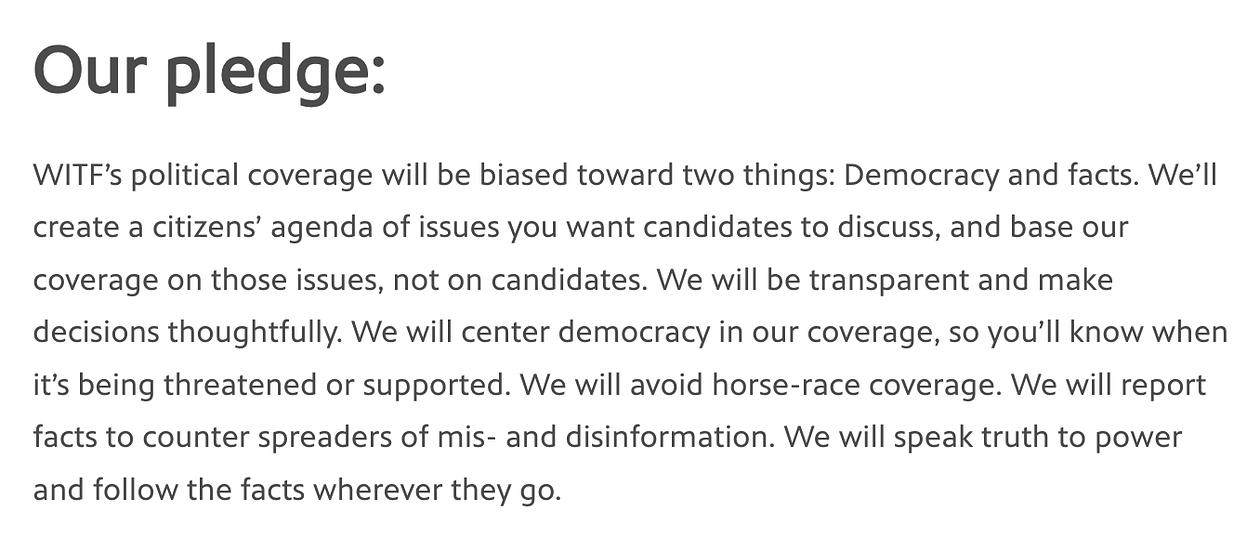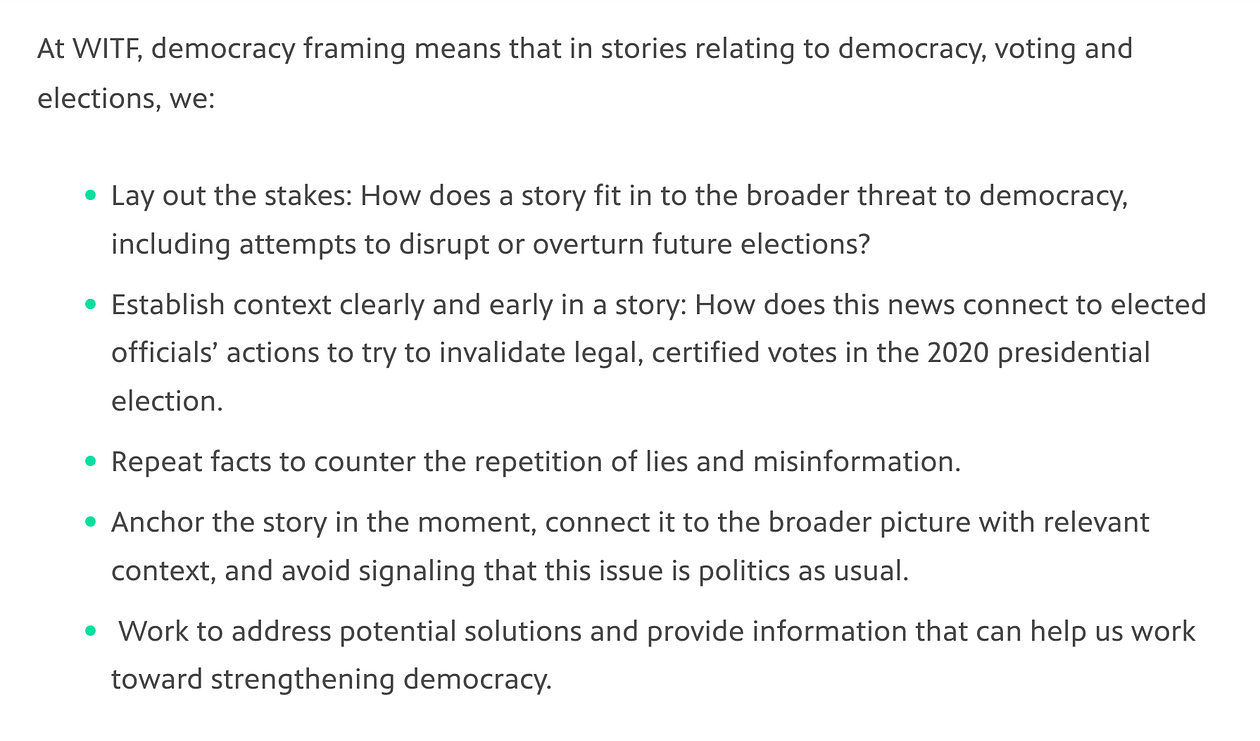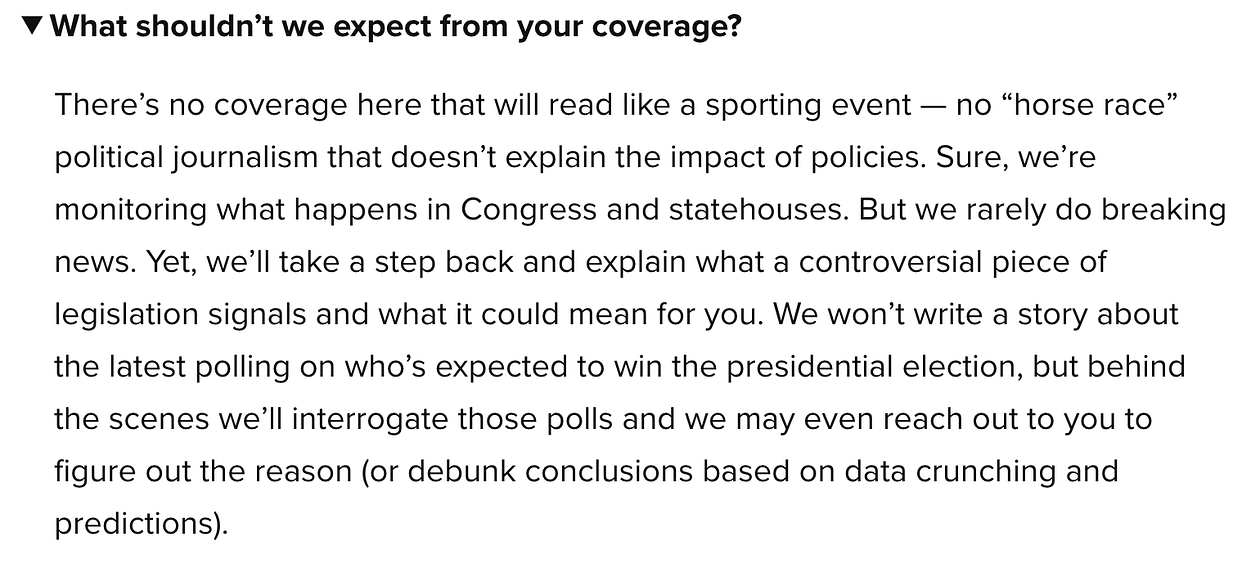
Journalists, get inspired by how these two local newsrooms are inviting accountability and transparency into their elections coverage.
Copy these 5 things from Capital B’s and WITF’s election FAQs
We’ve written a lot lately about how newsrooms should get on the record about their approach to covering elections. We figure if we can keep bringing you new examples, maybe you’ll be exposed to the nudge you need (or your boss needs!) to invest in telling the story of your work.
In case a piece of depressing data can provide that nudge, here you go: According to a study released last week by the Media Insight Project, about half of U.S. adults say they have “a great deal” or “a moderate amount” of trust in news about the 2024 elections. The rest say they “only a little” or none.
When I read research like that, I try to push quickly through my denial, frustration, anger and defensiveness. I instead picture myself sitting down with someone who’s skeptical of the news. In that conversation, I would try to validate their skepticism — OF COURSE you can’t believe everything you hear! OF COURSE some things done in the name of journalism are irresponsible! — and figure out what I could tell them that might resonate with them about the trustworthiness of the kinds of journalism I believe in.
Some newsroom transparency efforts feel generic. Sometimes they’re full of platitudes and don’t really help me understand what the newsroom believes in or how they operate.
But sometimes they get so specific — tell such a compelling story — that I wish other newsrooms would follow their lead. That’s the theme of today’s Trust Tips.
I’m going to highlight sections of Election FAQs from two newsrooms. One, WITF in Harrisburg, Pennsylvania, has worked with Trusting News since 2017. Their team and their practices are well known to us, and they’re always willing to have us push them to go further. (You might call them a Trusting News teacher’s pet!) The other, Capital B, is new to working with us. I’m coaching them as part of this year’s Advancing Democracy fellowship. And they, too, have shown a desire to be pushed beyond the basics.
These two FAQs are very different from each other. That’s appropriate — they’re very different newsrooms and audiences. The idea isn’t to copy what another newsroom does. It’s to get inspired by the commitment newsrooms have made to inviting accountability and trust through transparency.
So with that, here are five things these two Election FAQs do well that I’d love to see other newsrooms take inspiration from. This post is longer than usual because it includes a bunch of details. I know it can be helpful to have language to be inspired by or borrow from, so here you go!
Huge thanks to Scott Blanchard, Tim Lambert and the rest of the leadership team at WITF, and to Dalila-Johari Paul, Brandon Tensley and their colleagues at Capital B.
1. Address topics people are actually curious or frustrated about
Check out this partial list of questions addressed in WITF’s FAQ. The staff talks about polling, fact-checking and use of labels, among other topics.

And do you see that question that goes right to the heart of trust — how will the newsroom report fairly on Trump while also being bold in coverage of, in their own words, “the 2020 election-fraud lie” and how Jan. 6 was “an attempt to overthrow representative democracy in America.” Here’s part of their answer to the Trump question.

Capital B dives right into something many newsrooms shy away from — how they’ll be mindful of the diversity of lived experiences in their audience and on their own team.

2. Highlight your values
Both WITF and Capital B tell a compelling story about what they believe in.
WITF has this pledge in a box next to the FAQ.

Capital B writes about how democracy must mean multiracial democracy, which didn’t really exist in the US until the passage of the 1965 Voting Rights Act. They take seriously the role of the Black press. They also include this description of the team’s three-part approach to coverage.

3. Get specific, so people know what to hold you accountable for
Both newsrooms get specific enough in their descriptions that people will be able to picture what they mean. (That’s tough — journalists often rely on insider jargon to describe their work.) And be sure to invite that accountability as part of your FAQ.
Here’s WITF:

Capital B gets specific about what their small team will and won’t cover, whether it’s on their site or in their politics newsletter. Readers can picture from this description how their coverage will be different.


4. Back up facts with receipts
If you’re going to treat something as a fact that a significant portion of your audience sees as an opinion, explain yourself. I want to relate this to one fact in particular. More than a third of Americans still question whether President Biden was legitimately elected. That’s more than did two years ago.
Some people who believe that are unpersuadable. But if someone who doesn’t follow news closely and is surrounded by pro-Trump talking points DOES decide to tune into the news and decide for themselves what is true, would they be able to?
An earlier draft of WITF’s mission statement included the first paragraph below. I pushed them to add the second, with links. I wish every newsroom would do this — and would link to it from daily coverage. Instead, we assume that because we’ve written previous stories and covered the relevant court cases — months and years ago at this point — the issue is settled. It’s not.

5. Wrestle with issues up front so they can help keep your coverage consistent on deadline
I’ve been able to witness as both these newsrooms have labored over language choices in these FAQs. They’ve deliberated. They’ve drafted. They’ve envisioned how their statements might play out in coverage.
In the case of WITF, I actually sat in (along with research partner Sue Robinson) on a few hours of editors’ meetings as they worked through how to cover this election cycle. The leadership team talked about how these guiding principles could be helpful when a new reporter and mid-level editor were crafting a Saturday daily story about a political rally. Would it be specific enough to help them make decisions? They opened it up to comment from staff before posting it and are open to revising and feedback comes in.
In the case of Capital B’s small national politics team, in a relatively new newsroom, creating an FAQ was part of the process of prioritizing. They had to first articulate their values to each other, so they could invite their audience to hold them accountable for living out those values in day-to-day coverage.
At Trusting News, we learn how people decide what news to trust and turn that knowledge into actionable strategies for journalists. We train and empower journalists to take responsibility for demonstrating credibility and actively earning trust through transparency and engagement. Subscribe to our Trust Tips newsletter. Follow us on Twitter and Facebook. Read more about our work at TrustingNews.org.

Executive Director Joy Mayer (she/her) founded Trusting News in 2016 after a 20-year career in newsrooms and teaching. She lives in Sarasota, Florida, and can be reached at joy@TrustingNews.org.



